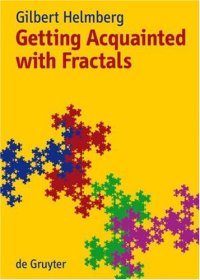
Ebook: Getting acquainted with fractals
Author: Gilbert Helmberg
- Genre: Mathematics // Analysis
- Year: 2007
- Publisher: Walter de Gruyter
- City: Berlin; New York
- Language: English
- pdf
The first instance of pre-computer fractals was noted by the French mathematician Gaston Julia. He wondered what a complex polynomial function would look like, such as the ones named after him (in the form of z2 + c, where c is a complex constant with real and imaginary parts). The idea behind this formula is that one takes the x and y coordinates of a point z, and plug them into z in the form of x + i*y, where i is the square root of -1, square this number, and then add c, a constant. Then plug the resulting pair of real and imaginary numbers back into z, run the operation again, and keep doing that until the result is greater than some number. The number of times you have to run the equations to get out of an 'orbit' not specified here can be assigned a colour and then the pixel (x,y) gets turned that colour, unless those coordinates can't get out of their orbit, in which case they are made black. Later it was Benoit Mandelbrot who used computers to produce fractals. A basic property of fractals is that they contain a large degree of self similarity, i.e., they usually contain little copies within the original, and these copies also have infinite detail. That means the more you zoom in on a fractal, the more detail you get, and this keeps going on forever and ever. The well-written book 'Getting acquainted with fractals' by Gilbert Helmberg provides a mathematically oriented introduction to fractals, with a focus upon three types of fractals: fractals of curves, attractors for iterative function systems in the plane, and Julia sets. The presentation is on an undergraduate level, with an ample presentation of the corresponding mathematical background, e.g., linear algebra, calculus, algebra, geometry, topology, measure theory and complex analysis. The book contains over 100 color illustrations.
Download the book Getting acquainted with fractals for free or read online
Continue reading on any device:

Last viewed books
Related books
{related-news}
Comments (0)